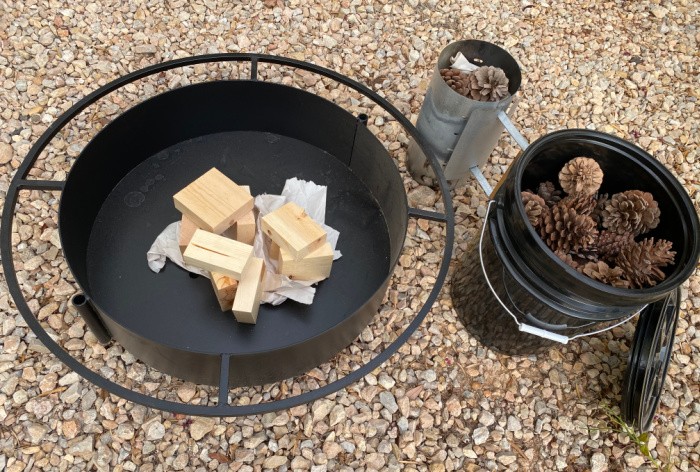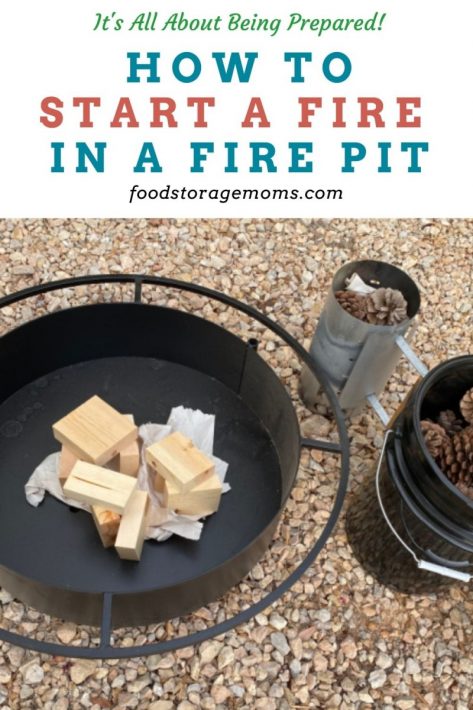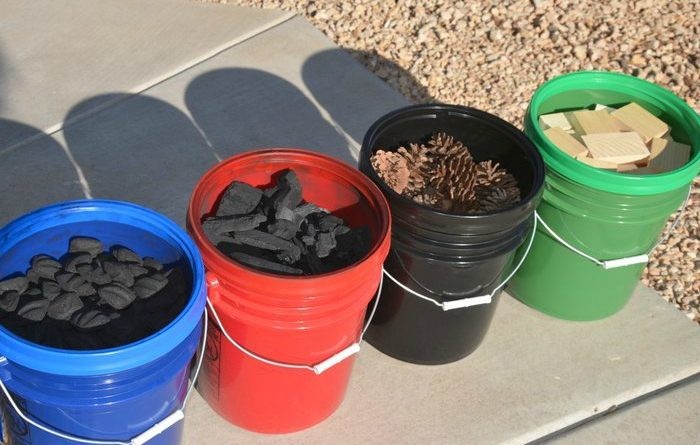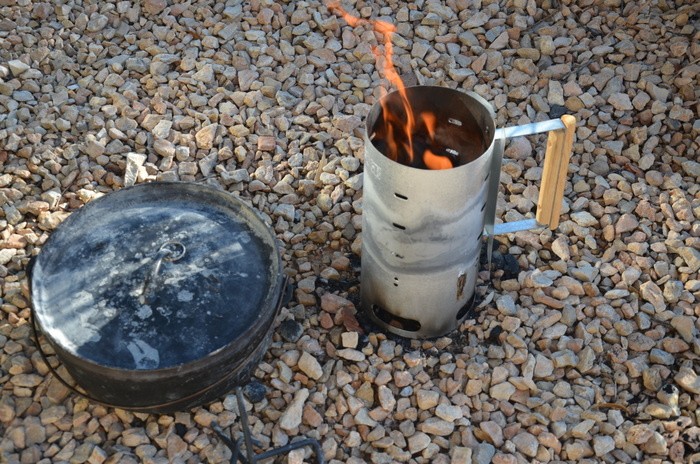
There aren’t many things I enjoy as much as gathering my family for an evening around a warm fire. When Mark and I lived in Northern Utah years ago, all four of our daughters and their families lived pretty close, and we’d get together for a BBQ, swimming, and a fun time around a fire. I’d encourage all my readers to do the same, and that’s why I’ve decided to write about how to start a fire in a fire pit.
Since man first discovered fire, gatherings with fire as a centerpiece have occurred. Of course, fires back then were a critical need for basic survival. Having fire available is a blessing that we all take for granted. We use fire to run our gas stoves for cooking, and we also have a form of fire in our gas furnaces to heat our homes.
Fires can also be experienced as part of a disaster when homes, forests, businesses, and more are consumed by fire and are out of control. Yes, depending on the circumstances, fire can be our friend and our worst enemy.
In this post, I’d like to outline how having a fire pit available can be a true lifesaver during an emergency and how getting one started and maintained safely is essential information we can all use. In case you missed this post, My Favorite Emergency Fuel To Store For Survival

Why Should I Have a Fire Pit?
By the way, I’ve seen the term or word “fire pit” as both two words and one. I decided to use the two-word version for today’s post since it seems to be the most common usage.
Besides being a centerpiece for families during the good times, a fire pit can be the mainstay for your family’s ability to prepare meals and keep warm when a disaster hits. Firepits are a convenient way to cook foods outside if your in-home cooking options aren’t available. They are also a source of heat if you are forced to live or sleep outside for any reason.
Do I Need to Buy a Fire Pit, or Can I Make My Own?
Mark and I bought a metal firepit a few years ago. One of the attractive things about ours is that it’s small enough to move around our yard. We used to have a space in the backyard near our lawn to put it for an evening campfire or family fireside.
We can also put it on some rocks out front if we have some neighbors over for a fire during Halloween or other cool-temperature holiday get-togethers.
Many families will construct a more permanent fire pit in their yard. You need to find a location that’s not too close to possible fire hazards like a tree, shed, or even your home.
Fires can send off ashes with the slightest breeze, so be safe when locating and using the firepit.
I’ve seen firepits made of concrete, cinderblocks, bricks, flagstones, and metal. I’m not sure the building material makes a lot of difference. You just need to decide how big you want it and whether you want it lined on the bottom. Then, dig your hole and place the firepit rim or sides around the hole to the desired height and thickness.
Most firepits seem circular, but you could make it square or rectangular if that suits you and the space you have available.
What Should I Use as Fuel in My Fire Pit?
All fires need fuel to burn. Most backyard fire pits use various types of wood from large bushes or trees. To get the fire in the fire pit to start properly, you’ll need different sizes of wood pieces, and you’ll increase them as the fire gets bigger.
Let’s discuss the terms most frequently used:
Tinder
This fuel is usually tiny, dry, and quick to burn. You should consider gathering some tinder from easy-to-find things like newspapers, pine needles, pine cones, very small tree or bush branches, and even leaves.
This fuel is placed at the bottom of the fire pit and forms the base of the fire. Don’t compact the tinder, it needs air and space so the fire can not only start easily but flare up to the next level of fuel, the kindling.
Kindling
This is the fuel that is ignited by the tinder and lasts long enough for larger pieces of wood to burn. The idea is to grow your fire by gradually placing larger pieces of fuel on top of it.
It is best to form a cone or tee-pee-shaped bunch of wood pieces above the tinder in the size most of us call twigs, small tree branches, or dry sticks.
You start the fire by lighting the tinder, which ignites the kindling, which in turn causes larger branches or logs to burst into flame. As mentioned above, placing the kindling is essential so it gets plenty of air or won’t burn properly.
Firewood
Why is this fuel often referred to as seasoned firewood? It comprises split logs, large branches, or other larger pieces of wood. The keyword here is “seasoned.”
If you go out in the forest to gather firewood, it is hard to determine how old the wood might be. If you’re allowed to cut live trees, they represent the least seasoned wood available since they are still green.
Seasoned firewood has been given enough time to dry out fully. It should be kept under an overhanging cover or even a waterproof tarp for an extended period so it can dry out completely.
It could take months or even years for the soil to be dry enough to burn efficiently in your fire pit. The goal is a 20% % -30 % moisture content, but who knows how to measure that?

So How Do I Light the Fire in My Fire Pit
You’d think lighting the fire after all this preparation work would be the most straightforward task. That would be the case in a perfect world, but life doesn’t seem to go perfectly when it comes to fires.
You’ll find that wind and moisture are your biggest challenges in getting the fire going.
Mark tells me stories of being in the Boy Scouts and having to start a fire up in the mountains on a campout. Often, mountain breezes came into play, or a late afternoon rainstorm suddenly took the troop by surprise before they could get a fire going.
All Boy or Girl Scouts know we need matches to start a fire outside. Matches are fine, but they don’t put out much of a flame. If your tinder and kindling are small and dry enough, you can make them work.
Otherwise, you’ll need a larger flame, like a cigarette lighter or a butane torch lighter. Strikers are another option, for sure.
We have a bunch of butane torch lighters stored in our kitchen. They mostly work okay, but I wish they were made better to be more reliable. You have to push a button while you flip or roll a switch.
It usually takes me a few minutes to get one to light. Once they do light, the flame is generally sufficient to light the tinder, and away we go. I use one of these, Fire Starter Chimney. In the first picture above and the one below, you can see a circular tube with a handle attached. I call it my fire starter chimney, which has come in handy several times. With the tinder inside, you can more easily start the fire because the chimney helps protect against the wind, and the fire is more concentrated. They work great.

What Are Some Safety Issues When Using a Fire Pit
We discussed the importance of placing the firepit in a location with limited exposure to flammable materials. That also goes for the fuel you plan to burn during your cooking or campfire session. Keep those logs at a safe distance from the firepit itself until you’re ready to use them.
Don’t let the fire get too big, based on the size of the fire pit and what is nearby. Maintaining control is critical. Always have a large bucket or two of water, or even a water hose, close at hand so you can douse the fire if needed.
You’ll also want to extinguish the fire before you retire for the night fully. Don’t get lazy and think the fire will eventually die out and be safe. Use that water, to be sure. Look for any “hotspots” throughout the firepit itself.
Some tools you may want to have available so your fire pit experience goes as planned without any injury to you or a family member include a fire poker, tongs, and fireproof gloves. I’ve even seen people wear goggles, although that may be overkill. Better safe than sorry.
Final Word
Writing about fire pits has been fun and engaging. During my research, I’ve discovered some new ideas about starting a fire in a fire pit. We all enjoy a warm, friendly fire on those cool nights.
A fire pit can be the nucleus of a memorable family or neighborhood activity. The key is to start and maintain a brisk fire properly.
With the information shared today, that should be an easy task for any of my readers. Let’s all keep prepping and make the most of every day. May God bless this world. Linda
The post How To Start A Fire In A Fire Pit appeared first on Food Storage Moms.
from Food Storage Moms
No comments:
Post a Comment